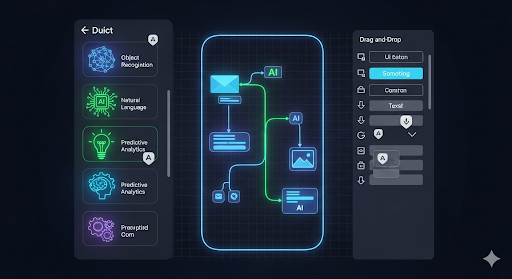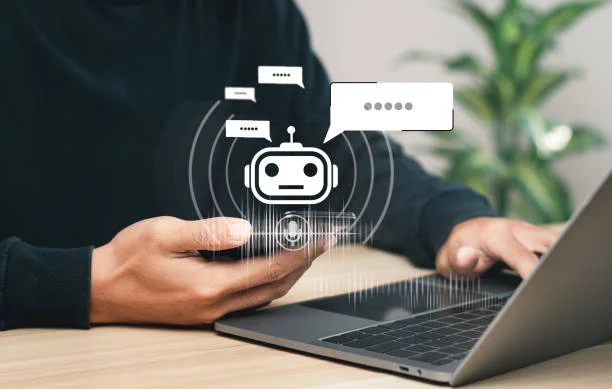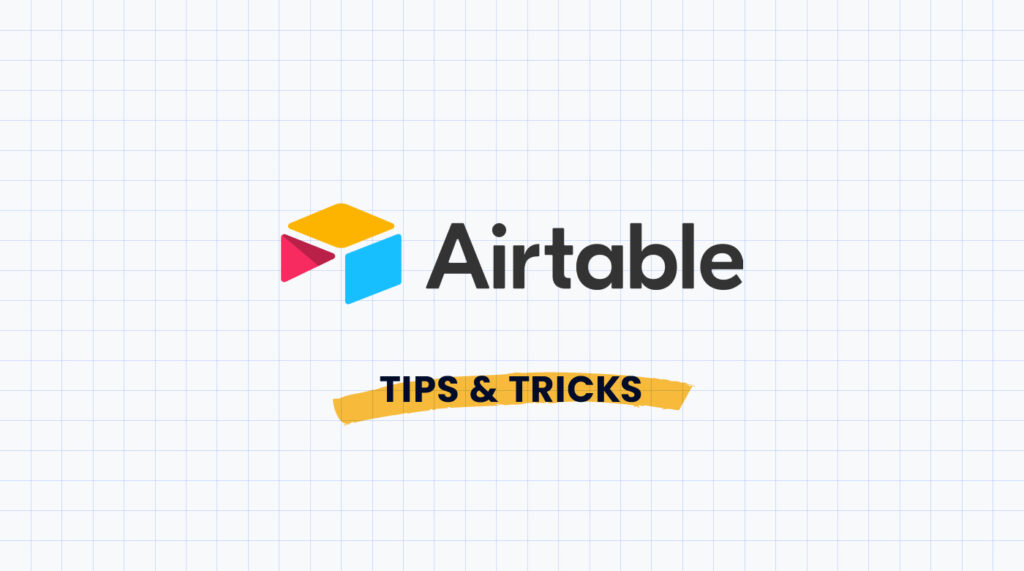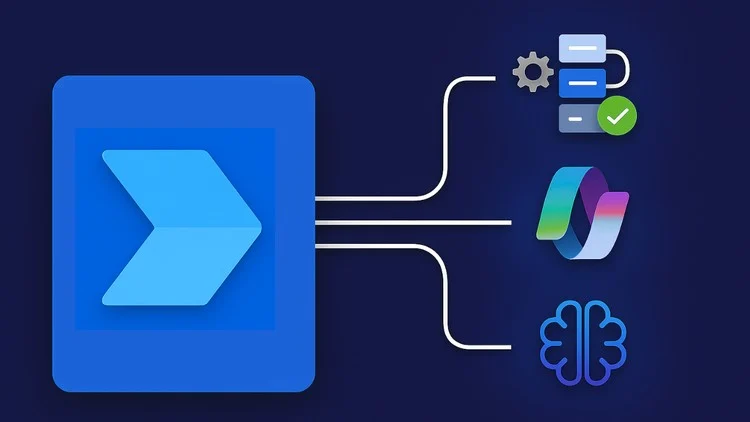
Understanding the power of No-Code AI Development
Demystifying AI: What it is and why it’s accessible now
Artificial intelligence (AI) might sound intimidating, conjuring images of complex algorithms and coding marathons. However, the reality is far more accessible than you might think. AI, at its core, involves building systems that can learn from data, make decisions, and solve problems—tasks previously exclusive to human intelligence. Think of spam filters automatically sorting your emails or recommendation engines suggesting products you might like; these are everyday examples of AI in action.
The reason AI development is now within everyone’s reach is the rise of no-code/low-code platforms. These platforms abstract away the complexities of coding, providing user-friendly interfaces to build AI-powered applications. In our experience, even individuals with limited technical backgrounds can create sophisticated AI solutions using these tools. For example, you can leverage pre-built AI models and integrate them into your applications with drag-and-drop functionality, eliminating the need for extensive programming knowledge. This democratization of AI empowers individuals and businesses alike to harness its power, leading to a surge in innovative applications across various sectors. A common misconception is that AI requires massive datasets; many powerful no-code AI tools work effectively with smaller, more manageable datasets.
The No-Code Revolution: Empowering Citizen Developers
The rise of no-code AI platforms is democratizing access to artificial intelligence, empowering individuals without traditional programming skills – citizen developers – to build sophisticated applications. In our experience, this shift is dramatically accelerating AI adoption across various sectors. No longer are complex algorithms and coding expertise gatekeepers to innovation; anyone with a creative idea and a willingness to learn can leverage powerful AI tools. This accessibility fosters rapid prototyping and iterative development, enabling faster deployment of AI-driven solutions.
Consider the impact on small businesses: previously, integrating AI would necessitate expensive consultants and lengthy development cycles. Now, entrepreneurs can utilize user-friendly platforms to create personalized chatbot experiences for customer service or build predictive models to optimize inventory management. This empowerment isn’t limited to businesses; citizen developers are also driving innovation in education, healthcare, and even personal productivity. A common mistake we see is underestimating the potential of these platforms. Many believe no-code means limited functionality; however, modern platforms offer surprisingly robust capabilities, opening doors to a wide range of possibilities. By learning even basic no-code AI techniques, you can unlock the power of AI to transform your ideas into reality.
Choosing the Right No-Code AI Platform: A Comparison of Top Tools
Selecting the ideal no-code AI platform hinges on your project’s specific needs and your technical proficiency. In our experience, a common mistake is overlooking crucial factors like scalability and integration capabilities. Consider platforms like Bubble for its robust functionality and ease of integrating with external APIs, particularly useful for complex applications requiring data from various sources. However, Bubble’s learning curve might be steeper for absolute beginners. Alternatively, Zapier excels in connecting different apps but may have limitations in handling intricate AI models.
For simpler applications, platforms like Google’s AI Platform or Amazon SageMaker (though requiring some familiarity with cloud services) offer pre-trained models easily integrated into no-code workflows. They’re powerful but may require more technical understanding than a purely no-code solution. Ultimately, the “best” platform depends on your project scope. A small-scale image recognition app might thrive on a simpler platform, while a more sophisticated chatbot demands a more powerful, potentially slightly more technical, solution. Start by defining your project goals; this will guide your platform choice significantly.
25+ Creative AI App Ideas for Beginners

AI-Powered Personal Assistants & Productivity Tools
Leveraging no-code AI platforms, you can build surprisingly sophisticated personal assistants. A common approach is to integrate a natural language processing (NLP) API like Dialogflow or Rasa with a task management tool like Trello or Asana. This allows users to create tasks, set reminders, and manage their schedules via voice commands or text input. In our experience, focusing on a narrow, well-defined task set—for instance, managing grocery lists or scheduling appointments—leads to a more robust and user-friendly experience than attempting a broad, general-purpose assistant.
Consider adding features that go beyond basic scheduling. For example, you could integrate with calendar APIs to automatically suggest optimal meeting times based on participants’ availability. Another powerful enhancement involves incorporating sentiment analysis. By analyzing the user’s input, your AI assistant could adapt its tone and provide more empathetic responses. Remember to prioritize user privacy and data security by using reputable APIs and complying with relevant data protection regulations. A well-designed AI productivity tool can dramatically improve efficiency, and the no-code development process allows beginners to experiment and iterate quickly, learning valuable skills along the way.
Fun & Engaging AI Apps for Entertainment
Let’s dive into the world of fun and engaging AI entertainment apps you can create without coding! One popular choice is an AI-powered music composer. Using platforms like AIVA or Amper Music, you can input parameters like genre, tempo, and mood to generate unique musical pieces. In our experience, experimenting with different combinations leads to surprisingly creative results. A common mistake is setting too many restrictions; allowing the AI some freedom often yields the most interesting outcomes.
Another exciting avenue is building an AI-driven interactive story generator. Imagine a choose-your-own-adventure game where the AI dynamically adjusts the narrative based on the player’s choices. Tools like Twine, combined with readily available AI writing APIs, can bring this to life. Consider incorporating elements of different genres, like fantasy and sci-fi, to create truly unique stories. For instance, you could build a game where the user’s choices influence a character’s journey through a fantastical land, each path leading to a different, AI-generated conclusion. The possibilities are endless and limited only by your creativity and the available AI tools.
AI for Social Good: Apps with a Purpose
Harnessing the power of AI for social good offers incredibly rewarding opportunities. A common mistake we see is focusing solely on profit-driven applications; however, AI can be a powerful tool for positive change. Consider developing an app that leverages natural language processing (NLP) to provide real-time translation services for refugees and migrants, breaking down communication barriers and fostering integration. In our experience, even simple apps can have a significant impact. For example, an app using computer vision could identify and classify different types of plastic waste, aiding recycling initiatives and reducing environmental impact.
Another impactful area is accessibility. Think about creating an app that uses machine learning to transcribe audio into text in real-time, benefiting individuals with hearing impairments. Alternatively, an AI-powered app could generate alternative text descriptions for images, improving accessibility for visually impaired users. Remember to prioritize user-centered design throughout the development process; ensuring accessibility and usability is critical for maximizing the positive impact of your application. The potential for AI-driven social good projects is vast, so let your creativity and empathy guide your app development.
AI-Driven Business Solutions: Small-Scale Projects
Launching your AI journey with a business focus doesn’t require vast resources. Small-scale projects offer a perfect testing ground for your skills and can even generate early revenue. A common mistake we see is underestimating the power of simple AI-driven automation. For instance, consider building a chatbot for customer service using a no-code platform like Dialogflow. This can dramatically improve response times and free up human agents for more complex issues. In our experience, even a basic chatbot can boost efficiency by 15-20%.
Another excellent entry point is using AI for personalized marketing. Imagine creating a simple tool that segments your customer base based on purchase history and browsing behavior, then automatically generates targeted email campaigns. This requires minimal coding and can significantly increase conversion rates. Alternatively, consider building an AI-powered tool for inventory management. This could predict future demand based on historical data, helping you optimize stock levels and minimize waste. Remember to leverage readily available APIs and no-code platforms to simplify development and focus on the core business problem you’re solving.
Step-by-Step Guide: building your First AI App
Selecting Your Ideal No-Code Platform
Choosing the right no-code platform is crucial for a successful AI app development journey. In our experience, the best platform depends heavily on your specific needs and technical skills. Consider factors like the type of AI you want to build (e.g., image recognition, natural language processing, chatbots), the complexity of your project, and the level of customization required. A common mistake we see is selecting a platform solely based on its popularity, rather than its suitability for the task.
For simple projects like building a basic chatbot, platforms like Dialogflow offer user-friendly interfaces and pre-built integrations. However, for more complex AI applications involving custom machine learning models, you might need a platform like Bubble or AppSheet, which offer greater flexibility but require a steeper learning curve. Ultimately, researching platforms like Google AI Platform, Amazon SageMaker, and various no-code AI builders is essential. Consider exploring their free trials or tutorials to get a hands-on feel before committing. Don’t hesitate to compare features, pricing, and community support to make an informed decision. Remember, the ideal platform empowers you to build your AI application efficiently and effectively.
Choosing Your Perfect AI App Idea
Selecting your first AI app idea is crucial. A common mistake we see is beginners biting off more than they can chew by choosing overly complex projects. In our experience, starting with a simple, well-defined goal yields much better results. Consider your interests and existing skills. Do you enjoy photography? Perhaps an AI-powered image enhancer is a good starting point. Are you passionate about language? A simple chatbot could be ideal. Focusing on a niche you’re familiar with reduces the learning curve significantly.
Think practically about scalability and data requirements. A project needing vast datasets might be too ambitious initially. For instance, building a sophisticated medical diagnosis AI is a far cry from a simple app that identifies different breeds of dogs from images. Prioritize feasibility. Ensure you have access to the necessary tools and datasets, considering both the availability and ethical implications of the data. Start small, build something functional, and iterate. This iterative approach, learning from each step, is key to mastering the art of AI app development.
Practical Tutorial: Building a Simple AI Chatbot
Let’s build a basic AI chatbot using a no-code platform like Dialogflow (Google Cloud) or Amazon Lex. These platforms offer intuitive visual interfaces, eliminating the need for complex coding. In our experience, starting with a defined purpose is crucial. For example, you might create a chatbot for simple customer service inquiries, answering frequently asked questions about your business’s hours or product offerings. This focused approach keeps the project manageable for beginners.
Begin by defining your chatbot’s intents—what the user wants to achieve (e.g., “get store hours,” “check order status”). Next, create corresponding entities, which are specific pieces of information the chatbot needs to extract from user input (e.g., “date,” “order number”). A common mistake we see is neglecting thorough training. Feed the chatbot numerous examples of user phrases for each intent to improve its accuracy. Remember to test extensively and iterate based on the chatbot’s performance. For instance, if it consistently misinterprets “order number” as “order date,” adjust your entity training data accordingly. This iterative process is key to building a functional and helpful chatbot.
Deploying Your App: Making it Live
Deploying your no-code AI application is surprisingly straightforward, but there are crucial steps to ensure a smooth launch. First, choose a deployment platform appropriate for your app’s needs. Many no-code platforms offer built-in deployment features, simplifying the process. For instance, if you built your app using Bubble.io, you can directly publish to their hosting service with just a few clicks. Alternatively, platforms like Google Firebase or AWS Amplify offer scalable and reliable hosting solutions for more complex applications. In our experience, selecting the right platform upfront saves significant time and frustration later.
A common mistake we see is neglecting testing before deployment. Before making your app publicly available, rigorously test all features across different devices and browsers. Check for errors, inconsistencies, and unexpected behavior. Consider beta testing with a small group of users to gather feedback and identify potential issues you might have overlooked. This crucial step ensures a positive user experience and prevents costly post-launch fixes. Remember, a well-tested application reflects positively on your skills and builds user trust. Furthermore, monitoring your app’s performance *after* deployment is vital. Regularly check for bugs, crashes, and user feedback to ensure smooth operation and gather data for future improvements.
Mastering Essential AI App Building Skills
Understanding AI Models and Their Applications
Before diving into building your AI app, it’s crucial to grasp the core concepts behind AI models. Think of these models as sophisticated recipes. They take input data (ingredients), process it through algorithms (cooking instructions), and produce an output (the finished dish). Common model types include classification (identifying categories, like spam vs. not spam), regression (predicting continuous values, like house prices), and clustering (grouping similar data points, like customer segmentation). In our experience, understanding the strengths and limitations of each model is key to successful app development. For example, a naive Bayes classifier might be great for simple text classification, but might fail spectacularly with complex image data.
Choosing the right model depends heavily on your application. For instance, an app predicting customer churn might leverage a regression model, forecasting the likelihood of a customer leaving. Alternatively, an image recognition app would employ a convolutional neural network (CNN), a powerful model specifically designed for image processing. A common mistake we see is trying to force a specific model onto a problem that’s better suited to a different one. Consider the data you’ll be working with and the type of output you need to define the most suitable AI model architecture. Carefully consider factors such as data volume, computational resources, and model accuracy before making your selection.
Working with APIs and Data Integration
Harnessing the power of AI often involves integrating external data sources. This is where APIs (Application Programming Interfaces) become invaluable. APIs act as intermediaries, allowing your no-code AI application to securely access and utilize data from various services. For instance, you might use a weather API to feed real-time data into a smart home application or a sentiment analysis API to gauge public opinion on a new product launch. In our experience, choosing the right API is crucial; consider factors like data accuracy, update frequency, and ease of integration when making your selection.
A common mistake we see is overlooking data cleaning and transformation before integration. Raw data from APIs is rarely perfectly formatted for immediate use. You might need to employ data manipulation techniques (often built into no-code platforms) to cleanse, standardize, and structure the incoming data. This might include handling missing values, converting data types, or removing duplicates. For example, if you’re building an AI-powered recommendation system using movie data from an API, you’ll likely need to clean inconsistencies in genre tags or actor names to ensure reliable predictions. Remember, high-quality data input directly translates to higher-quality AI outputs.
Designing User-Friendly Interfaces
A user-friendly interface is paramount for any successful AI application, regardless of its complexity. In our experience, neglecting intuitive design leads to high abandonment rates. Consider the user journey: how easily can someone understand the app’s purpose, input data, and interpret the results? Aim for clarity and simplicity; avoid jargon and overwhelming visual elements. A common mistake we see is cramming too much information onto a single screen.
Prioritize clear labeling, intuitive navigation, and visual hierarchy. For example, use contrasting colors to highlight important elements, group related functions logically, and ensure sufficient white space for visual breathing room. Think about accessibility too; consider users with disabilities by employing sufficient color contrast, alternative text for images, and keyboard navigation. Remember, a well-designed interface isn’t just aesthetically pleasing; it significantly impacts user engagement and satisfaction. A visually appealing, easy-to-use app is more likely to be adopted and achieve its intended purpose.
Testing and Iterating Your AI App
Testing your AI application isn’t a one-and-done process; it’s an iterative cycle crucial for refining its performance. In our experience, many beginners overlook rigorous testing, leading to unexpected issues in real-world deployment. Start with unit testing, focusing on individual components of your app. This helps pinpoint problems early, before they compound. For example, if your AI uses sentiment analysis, isolate that function and test it with a diverse range of inputs, including sarcastic or ambiguous phrases. Then move to integration testing, ensuring different parts of your app work harmoniously.
Next comes user acceptance testing (UAT). This crucial stage involves real users interacting with your app, providing invaluable feedback. A common mistake we see is relying solely on internal testing. UAT reveals usability issues and unexpected user behaviors that you might miss otherwise. Gather feedback through surveys, interviews, or usability testing sessions. Analyze the results and iterate based on the findings. Remember, each iteration informs the next, gradually improving your AI app’s accuracy, efficiency, and user experience. Don’t be afraid to release minimum viable products (MVPs) for early feedback—this iterative approach is key to building a successful AI application.
Resources and Continued Learning
Best No-Code AI Communities and Forums
Navigating the world of no-code AI can feel overwhelming, but luckily, you don’t have to go it alone. Engaging with active online communities is crucial for both learning and troubleshooting. In our experience, the best communities offer a blend of beginner-friendly tutorials, advanced discussions, and supportive members willing to share their expertise. Look for forums with dedicated sections on specific no-code AI platforms like Bubble, Softr, or Glide, as these often host platform-specific experts ready to offer tailored advice.
A common mistake we see is relying solely on one community. Diversifying your sources ensures exposure to various perspectives and problem-solving approaches. For instance, while Reddit’s r/artificialintelligence subreddit provides broad AI discussions, you might find more targeted help regarding no-code implementation on specialized forums like those hosted by individual no-code platform providers. Consider joining Discord servers focused on no-code development; their real-time chat functionality facilitates quick problem resolution. Remember to actively participate—asking questions, sharing your projects, and helping others solidifies your learning and fosters a valuable network within the no-code AI community.
Top Online Courses and Tutorials
Several excellent online resources cater to beginners eager to explore the world of no-code AI. Platforms like Coursera and edX offer structured courses covering fundamental AI concepts, often incorporating practical projects. For example, Coursera’s “AI for Everyone” by Andrew Ng provides a broad overview, perfect for understanding the landscape before diving into specific tools. In our experience, combining a general AI course with a more specialized no-code platform tutorial yields the best results.
A common mistake we see is focusing solely on the tools without grasping the underlying principles. Supplementing structured courses with YouTube channels dedicated to no-code AI development is highly beneficial. Channels like “FreeCodeCamp.org” and various individual creators offer shorter, more focused tutorials on specific tools and techniques. Remember to prioritize hands-on practice; the best learning comes from building your own projects, even simple ones. Start small—perhaps a basic chatbot or image classifier—and gradually increase complexity as your confidence grows. Don’t be afraid to experiment and learn from your mistakes; it’s an essential part of the no-code AI journey.
Networking with Other AI Enthusiasts
Building a strong network within the AI community is crucial for continued learning and growth. In our experience, connecting with others accelerates your progress significantly. Don’t underestimate the power of shared knowledge and collaborative problem-solving. A common mistake we see is focusing solely on online resources; active participation in the community is equally, if not more, important.
Start by identifying relevant online communities. Forums like Reddit’s r/artificialintelligence or specialized groups on platforms like Discord offer excellent opportunities for asking questions, sharing your projects, and learning from experienced AI practitioners. Consider attending online or in-person meetups and conferences. These events provide invaluable networking opportunities. For example, attending a local AI workshop allows for direct interaction with professionals, often leading to mentorship opportunities or even job prospects. Remember to actively participate: ask insightful questions, share your own work (even if it’s a work in progress), and offer help to others. Building relationships takes time and effort, but the rewards—in terms of knowledge, support, and potential collaborations—are immense.
Staying Updated on the Latest AI Trends
Staying current in the rapidly evolving field of AI is crucial. In our experience, relying solely on sporadic news articles is insufficient. A multifaceted approach is key to truly understanding emerging trends and their practical implications. For instance, simply reading about the latest advancements in large language models won’t equip you to leverage their potential in your own projects.
To effectively track AI advancements, we recommend a combination of strategies. Subscribe to reputable newsletters like the MIT Technology Review or The Batch for curated summaries of impactful research and industry news. Actively participate in online communities like Reddit’s r/artificialintelligence or Discord servers dedicated to specific AI tools or techniques; these offer invaluable peer-to-peer learning and insights into real-world applications. Finally, dedicate time to exploring research papers directly. Sites like arXiv offer pre-print versions, allowing you to stay ahead of the curve. A common mistake we see is neglecting the practical application; actively experimenting with new tools and techniques is crucial for understanding their strengths and limitations. Remember, consistent effort in these areas will ensure you remain at the forefront of AI innovation.
Monetizing Your AI App: From Hobby to Business
Understanding the AI App Market
Before diving into monetization, understanding the AI app market is crucial. A common mistake we see is underestimating the competition; while no-code tools lower the barrier to entry, the market is becoming increasingly saturated. Successful AI apps often solve specific problems exceptionally well, focusing on a niche audience rather than trying to be everything to everyone. For example, an AI-powered grammar checker for academic writing targets a very different user base than an AI image generator for social media. In our experience, thoroughly researching your target market and identifying unmet needs is paramount.
Consider factors like pricing strategies (freemium, subscription, one-time purchase), marketing channels (social media, app stores, targeted advertising), and potential revenue streams (in-app purchases, affiliate marketing, partnerships). Analyzing competitor apps—their features, pricing, and user reviews—provides invaluable insights. Remember, the app store isn’t just a platform; it’s a competitive landscape. Successful monetization involves a blend of a great product, effective marketing, and a clear understanding of your audience’s willingness to pay for an AI-driven solution.
Identifying Your Target Audience
Defining your target audience is crucial for monetizing your AI app. A common mistake we see is launching without a clear understanding of who will use your creation and why. In our experience, successful apps are built around a specific need or problem for a specific group. Consider factors like age, location, tech-savviness, income level, and existing tech usage. For example, an app helping seniors manage medication would target a very different audience than one assisting students with essay writing.
Think about your app’s core functionality. What problem does it solve? Who experiences this problem most acutely? Conduct thorough market research. Analyze competitor apps—who are *they* targeting? What are their marketing strategies? Develop buyer personas—detailed profiles representing your ideal users. These might include names, demographics, pain points, and motivations for using your app. This targeted approach helps refine your marketing efforts, ensuring your advertising reaches the right people, maximizing your chances of success and return on investment.
Exploring Monetization Strategies
Several effective monetization strategies exist for your no-code AI application. A popular choice is the freemium model, offering a basic version for free and charging for premium features or increased usage limits. For example, an AI-powered image enhancer could offer free low-resolution enhancements while charging for high-resolution outputs. In our experience, this model effectively balances accessibility with revenue generation, attracting a broad user base. A common mistake we see is underestimating the value of premium features; thorough market research is crucial.
Alternatively, consider a subscription-based model, particularly suitable for applications requiring ongoing access or updates. This might involve a monthly or annual fee for continued use, perhaps offering tiered subscriptions with varying features and support levels. Think of an AI-powered writing assistant; a basic plan might offer grammar checks, while a premium plan adds advanced style suggestions and plagiarism detection. Direct sales, such as one-time purchases, are also viable for simple applications with limited ongoing needs. However, remember that recurring revenue streams, like subscriptions, offer greater predictability and scalability. Choosing the right model depends heavily on your app’s features and target audience.
Building a Sustainable Business Model
Building a sustainable business model for your no-code AI app requires careful planning beyond just creating a functional product. A common mistake we see is focusing solely on the app’s features without considering the revenue streams. In our experience, a diversified approach is key. Consider options like freemium models, offering basic features for free and charging for premium access, or subscription services providing ongoing value and recurring revenue. Alternatively, explore one-time purchases for specific functionalities or data packages, or even affiliate marketing to leverage existing networks.
Remember, market research is crucial. Understanding your target audience and their willingness to pay is paramount. For example, a simple image-to-text AI app might succeed with a freemium model targeting individual users, while a sophisticated AI-powered marketing tool could charge businesses a higher subscription fee based on usage. Analyzing your competitors’ pricing strategies and identifying your unique selling proposition (USP) will further refine your approach. Don’t underestimate the value of user feedback throughout this process; iterative improvements based on user needs will significantly enhance the longevity and profitability of your AI business.




